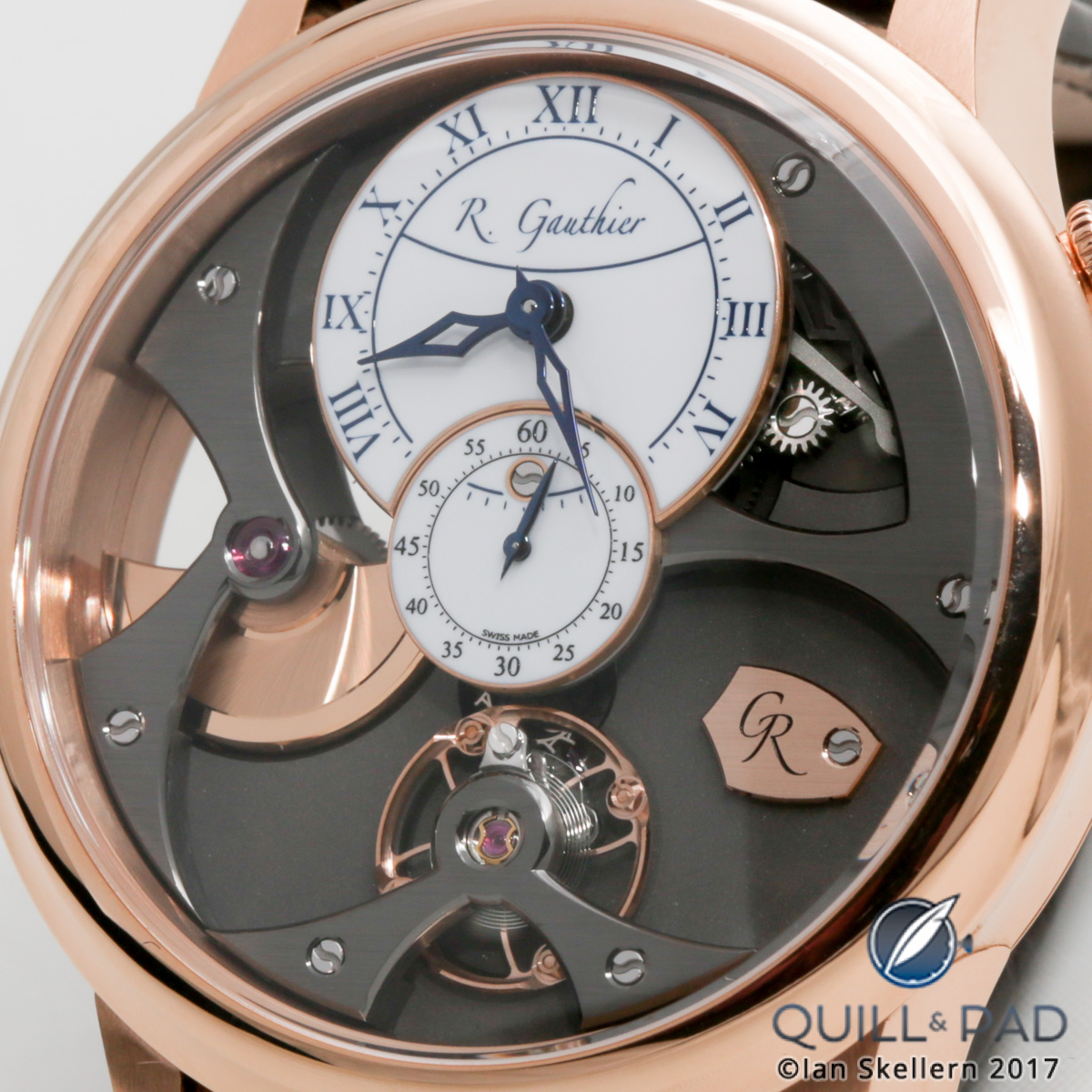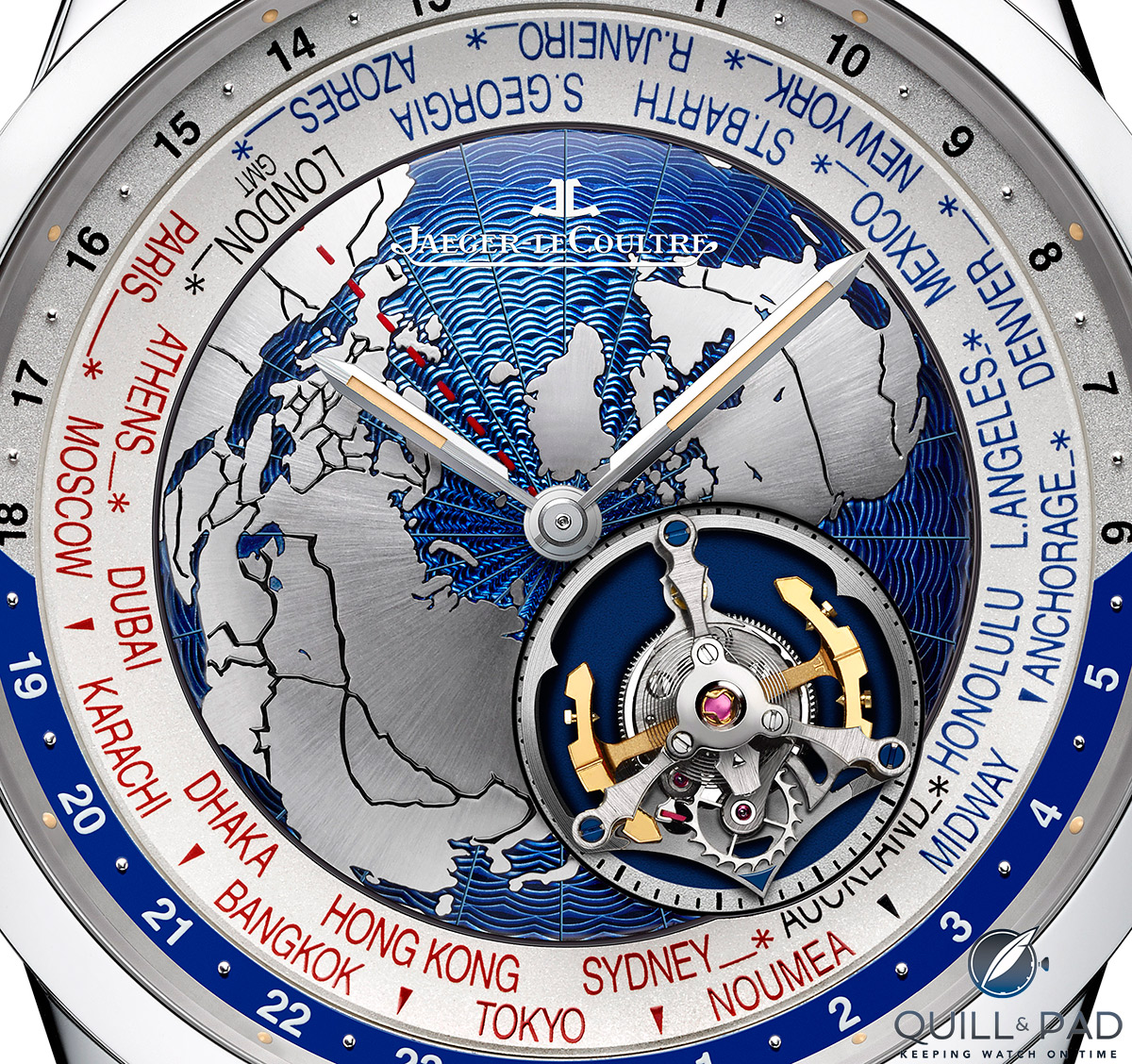
What is an orbit? According to NASA, “an orbit is a regular, repeating path that one object in space takes around another one.” The key words there are “in space.”
Newton’s First Law states, “. . . an object in motion stays in motion with the same speed and in the same direction unless acted upon by an unbalanced force.” It’s sort of like a merry-go-round, but one with just horses and empty space.
The difference between one object orbiting another, like satellites or the moon around the earth, and an object simply rotating regularly around another, like a car around a circular track or a ball swung on a rope around your head, is that in an orbit the unbalanced force is provided by gravity rather than mechanical means like rope or friction of tires on a track.
Or the dial of a watch.
According to Newton, orbits should be explained simply by the force of gravity acting on another body, but according to Einstein, space time itself is actually curved, like a heavy ball on a sheet, which causes objects to “fall” into each other. The Newtonian method is a rough approximation of how orbits work, but Einstein’s general relativity theory helps to explain it more precisely, and so orbital mechanics became a hard science. Of course, the world of the big and the world of the small behave differently because of different forces, and mechanics in a watch are unique as well.
So with your newfound understanding of orbital mechanics, you are ready to discover and explore the newest edition to the Jaeger-LeCoultre Geophysic collection, the Tourbillon Universal Time and its orbiting flying tourbillon with Gyrolab balance.
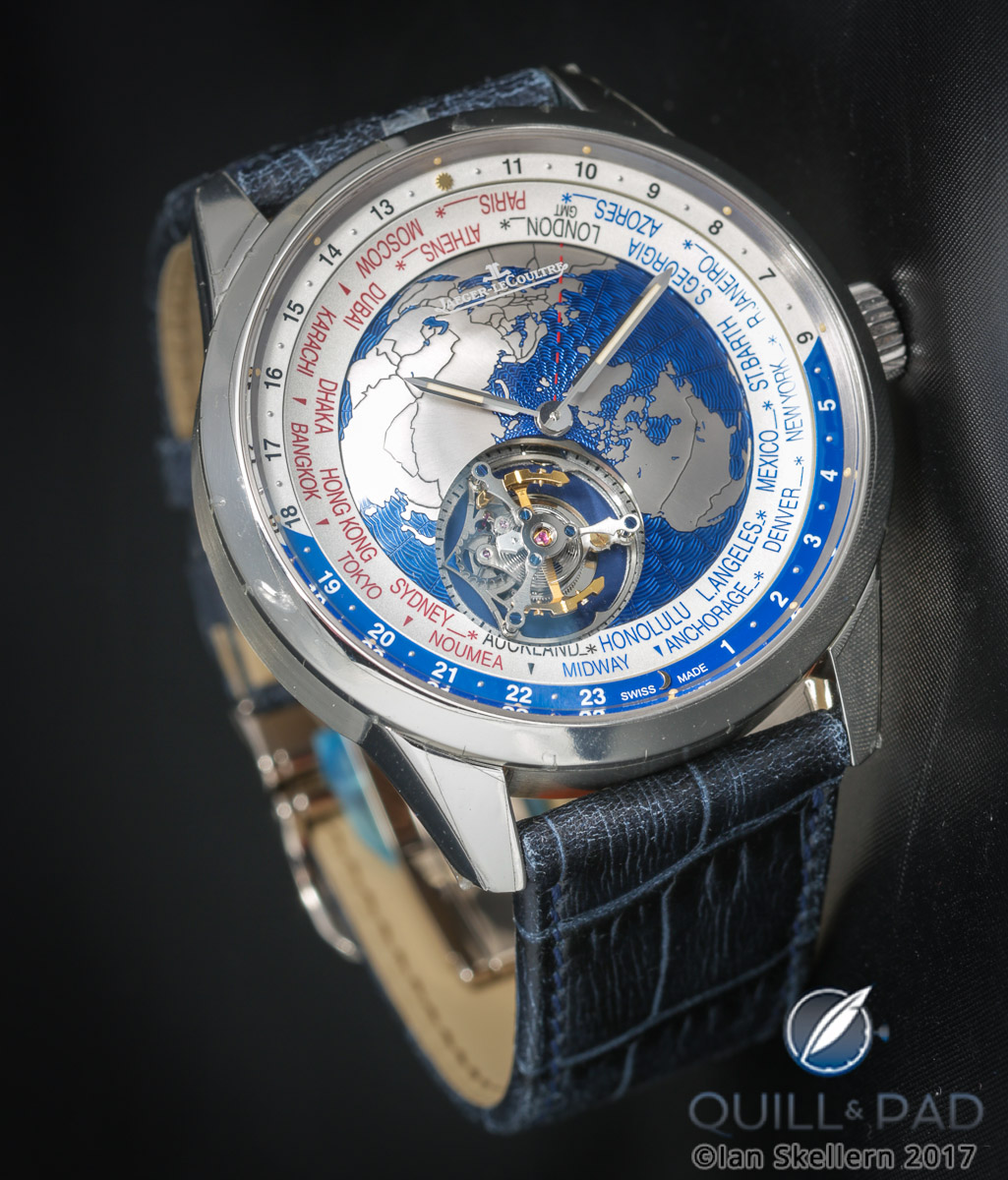
Jaeger-LeCoultre Geophysic Tourbillon Universal Time
It’s cool stuff: this latest take on the Universal Time is the first time a flying tourbillon has been mated with a world timer. A flying tourbillon requires no upper bridge support, so the toubillon cage is much more open to view than a normal tourbillon.
Orbit, schmorbit
The flying tourbillon rotates within a cutout of the world map dial in the Pacific Ocean, eliminating Alaska, eastern Russia, and part of Japan. Collectors in those areas might be a bit disappointed to find they didn’t make the cut, but the flying tourbillon should make up for it, especially when you consider that it orbits the dial every 24 hours.
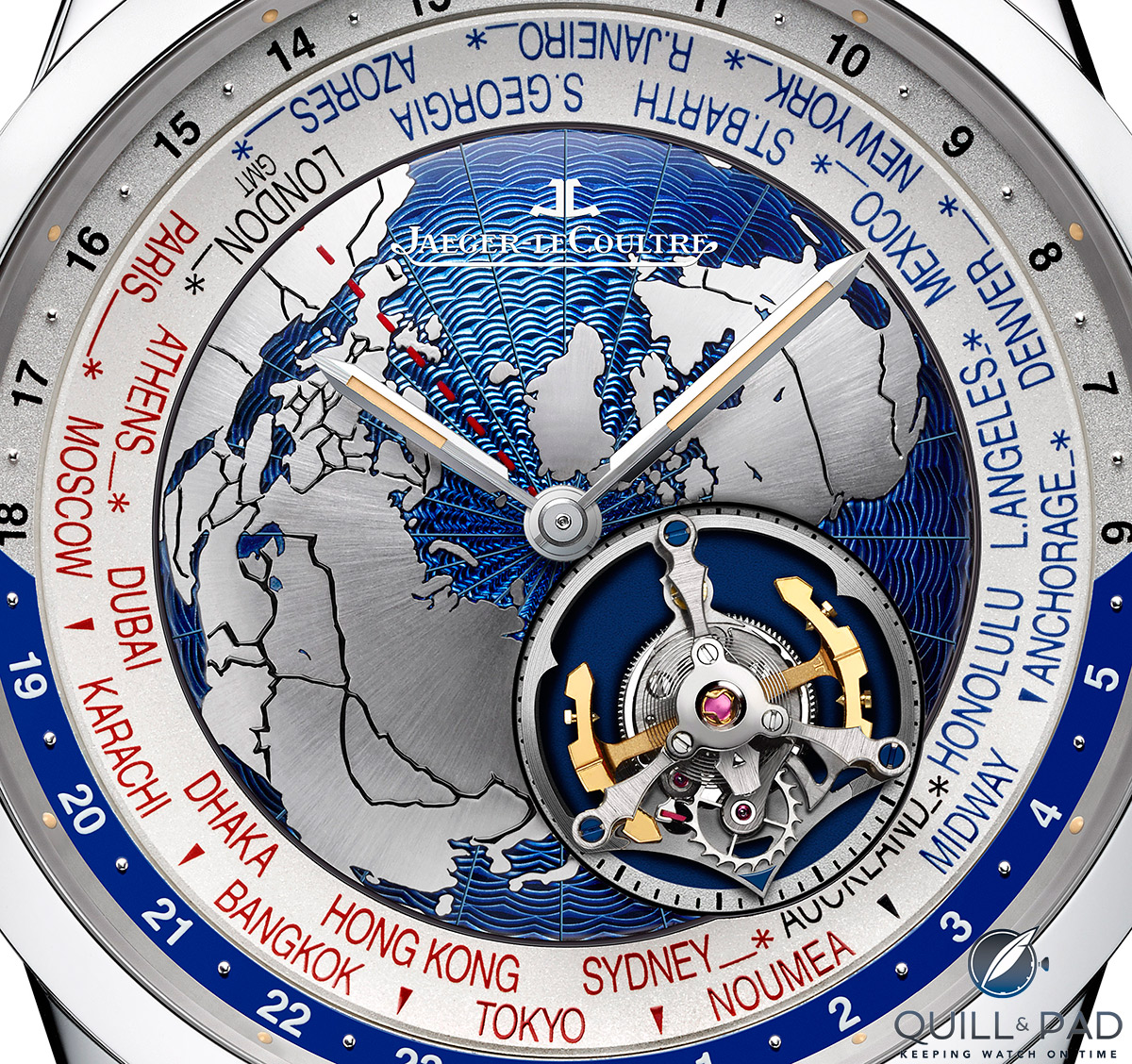
Jaeger-LeCoultre Geophysic Tourbillon Universal Time
For full scientific disclosure, it doesn’t actually orbit the dial but rotate with the dial, though I like the image of an orbiting tourbillon, given the relationship to the miniature globe. You might say this is Jaeger-LeCoultre’s latest foray into geosynchronous space satellites.
Or not.
Regardless, the flying tourbillon, which indicates the seconds during its one-minute rotation, also displays day and night and the 24 time zones around the world. Outside the domed globe dial, a track features cities representing the 24 time zones and a smaller 24-hour ring for determining the time in all locations as well as a day/night indication in the various time zones.
This is similar to the standard Geophysic Universal Time (see Stunning Geophysic Collection From Jaeger-LeCoultre: True Second And Universal Time), however the actions of all these parts have changed.
The city ring and the 24-hour day/night ring have been switched so that the city ring can rotate with the dial while the 24-hour ring stays fixed. I think that makes for a much more natural way to read the time around the world instead of with the rotating 24-hour ring.
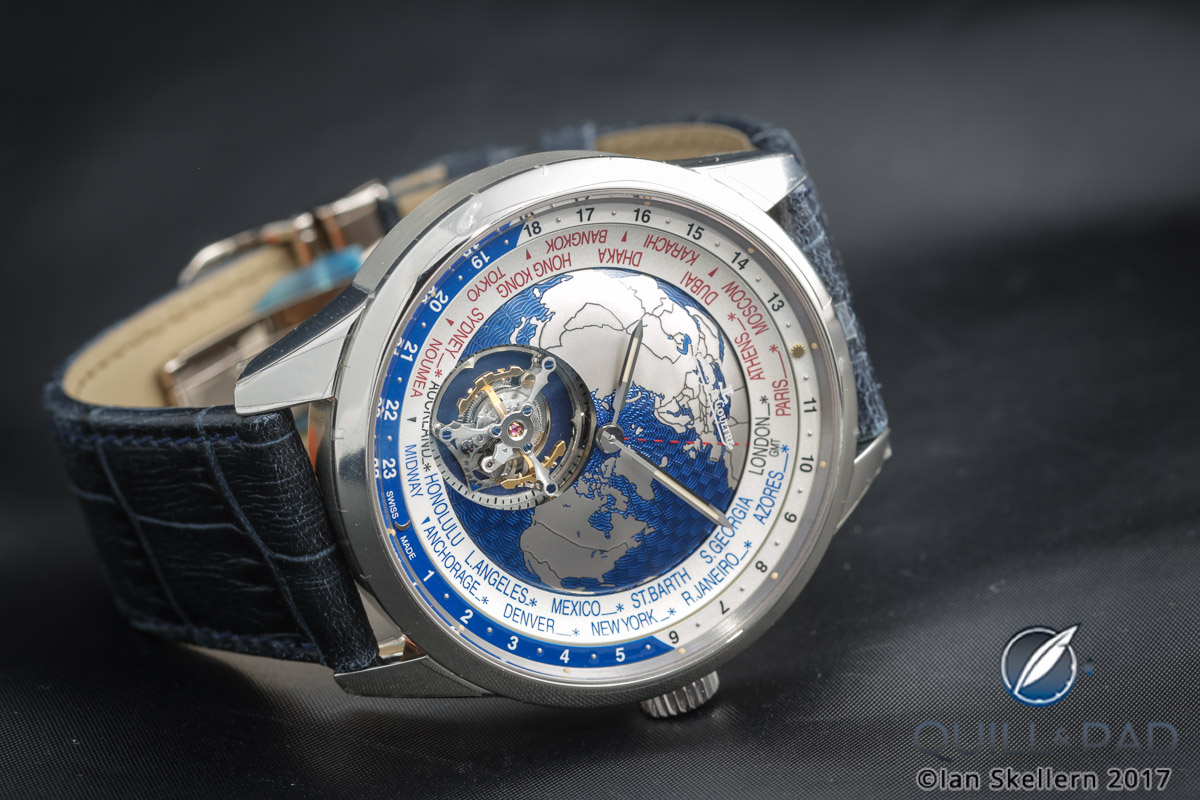
Jaeger-LeCoultre Geophysic Tourbillon Universal Time
The stationary time zone index ring combined with the orbiting cities allows for a quick glance to understand the time around the world, aided by the day/night separation.
Even more cleverly, the dial and tourbillon orbit counterclockwise to mimic the rotation of the earth, with the sunrise in the east and the sunset in the west. This is different from the Geophysic Universal Time, whose 24-hour ring rotates clockwise, but still maintains the correct relationship to the cities and sunrise/sunset but without the natural movement of the earth’s rotation.
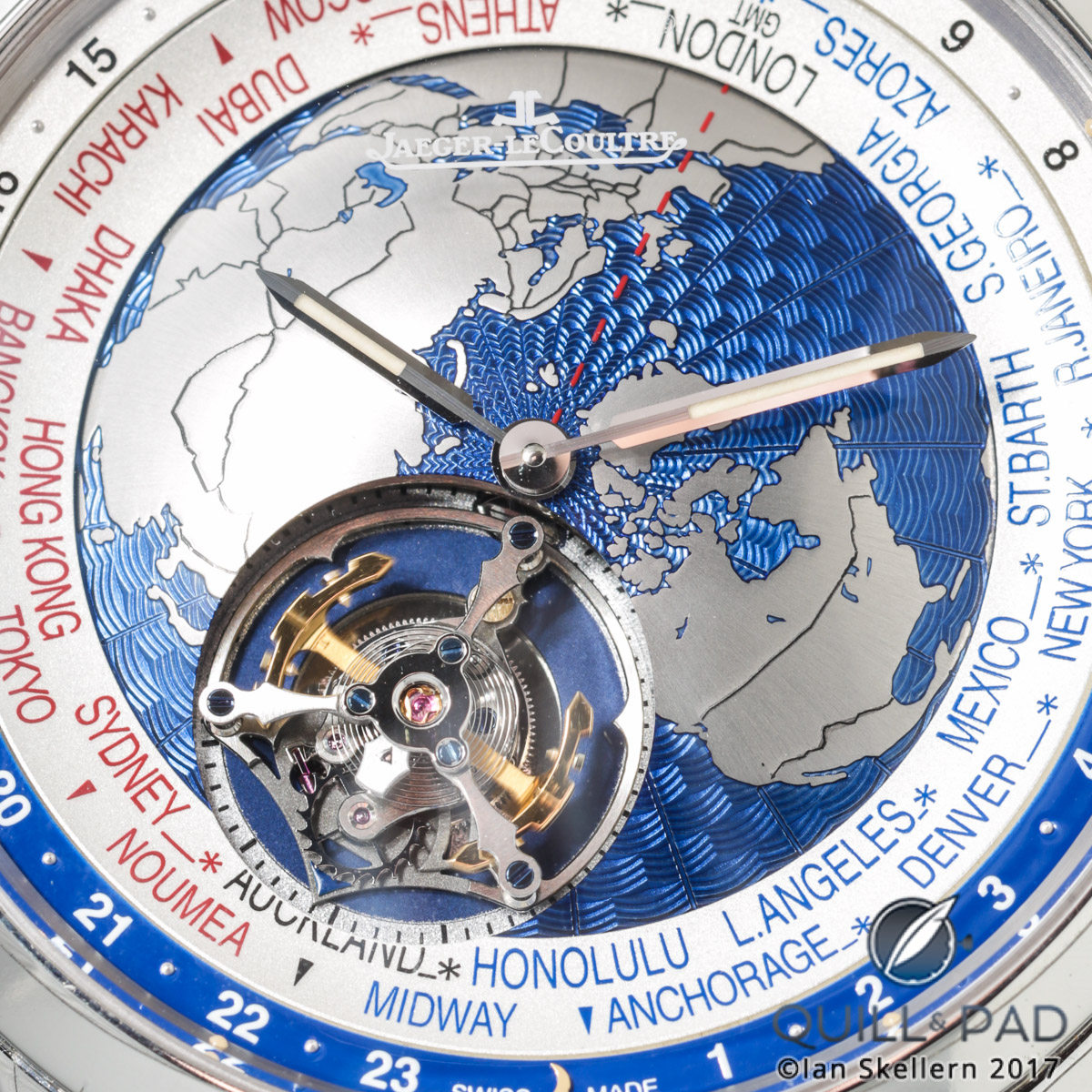
Dial of the Jaeger-LeCoultre Geophysic Tourbillon Universal Time
Design choices
Of course that is really a matter of preference, but when creating an orbiting flying tourbillon to display true world time, accurate celestial movement is always a plus.
Speaking of the flying tourbillon, its location on the dial isn’t simply due to there being a lot of space in the Pacific Ocean (certainly there is a lot of room, though) but to the fact it is located on the International Date Line, opposite the Greenwich Mean Time (GMT) line passing through London.
GMT is actually marked with a dotted red line across the guilloché dial.
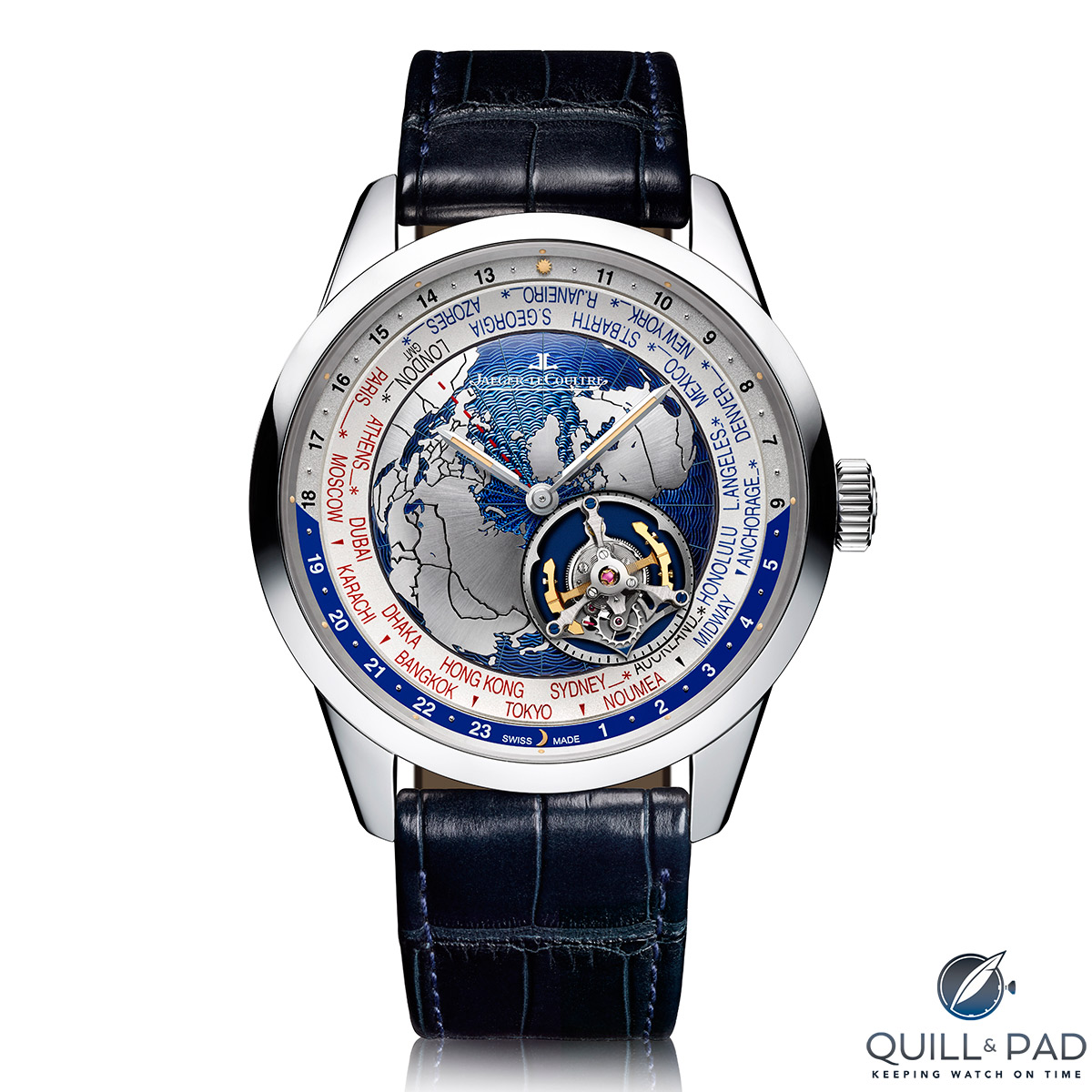
Jaeger-LeCoultre Geophysic Tourbillon Universal Time
This detail is accentuated with color elsewhere as well. The names of the cities are either in red (east of GMT) or blue (west of GMT) to help with faster reading of the different time zones. London and Auckland are both in black to denote the special relationships they have regarding time zones, GMT, and the International Date Line.
These details, though, aren’t very different from the original Geophysic Universal Time if we disregard the addition of the flying tourbillon.
A couple swapped indicator rings would be all, but the flying tourbillon really does change everything. It even changes the shape of the dial and the perception of the watch.
The dial is now dramatically domed to better represent a globe and to draw attention to the very smooth flying tourbillon with Gyrolab balance.
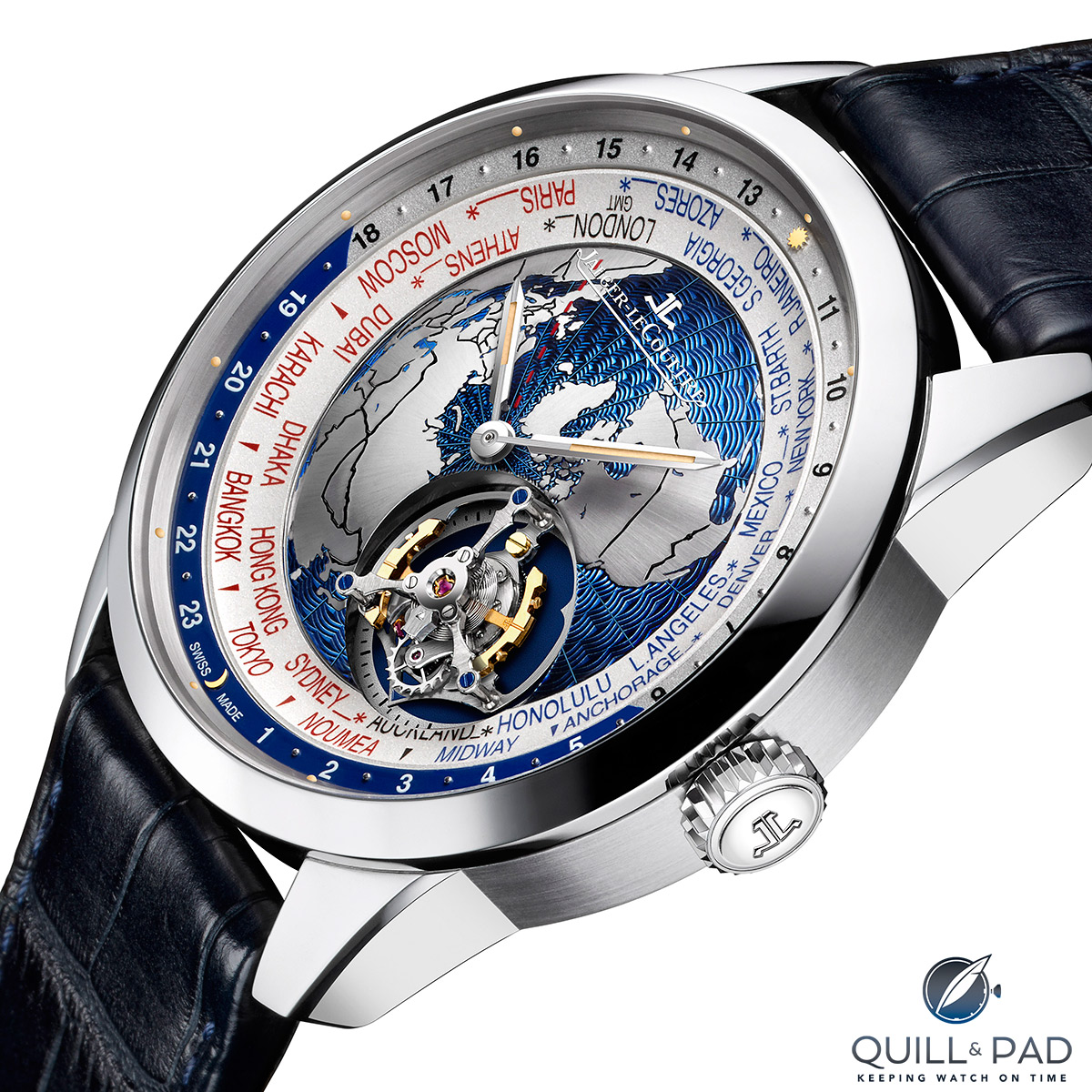
Jaeger-LeCoultre Geophysic Tourbillon Universal Time
One of the best ways to prominently feature a flying tourbillon is to mount it above the surface of the dial. Turning the dial into a globe does just that, helping to keep the thickness of the movement down as well. While the case is still a pretty hefty 14.9 mm thick, it doesn’t wear as big as it might if another brand were to have designed it.
Jaeger-LeCoultre has done a great job making this watch feel very wearable while also being a standout piece. This is really due to the watch’s intended use as a travel watch. It is supposed to be an accessory for the international man, not a showy wrist-yacht to impress others.
But at the same time, the Geophysic Tourbillon Universal Time shines as something different, something worth stopping to gawk at.
Other secrets to discover
All that gawking might still make you miss the undercover star of the Geophysic collection, the Gyrolab balance. Now standard on all Geophysic pieces, the Gyrolab balance is an improved and streamlined balance wheel design that first made its debut in the Master Compressor Extreme Lab 1 in 2007 and has been refined for production (no easy task) in the intervening years.

Jaeger-LeCoultre Geophysic Tourbillon Universal Time
The secret behind the Gyrolab balance was actually based on an assessment of aerodynamic performance resulting from surface area and air friction. The new design intends to reduce turbulence and air friction to increase rate consistency. In combination with the tourbillon (even if debating a tourbillon’s usefulness in a wristwatch), the precision of the Geophysic Tourbillon Universal Time is up there with the best and competes with C.O.S.C. standards.
When considering all that is part of the new Geophysic Tourbillon Universal Time, it is hard not to notice that this is one cool watch. It might not be everyone’s cup of tea due to its busy design (it is a world timer after all), but horology fans will appreciate the combination of functions and the application of the orbiting flying tourbillon.
I personally like this much better (surprise, surprise) than the standard Geophysic Universal Time. The loss of the True Second mechanism from the Universal Time model is regrettable, though having two displays of running seconds would be a bit overkill. But the loss is more than made up for by the accurately orbiting flying tourbillon and world map. It really is the most logical way to show world time in a visual format.
I really can’t wait for another chance to get the Tourbillon Universal Time on my wrist, or at least some more loupe time. Watching the orbit slowly creeping around the dial is fantastic, and knowing you can instantly check the time around the world is more than handy for someone that travels.
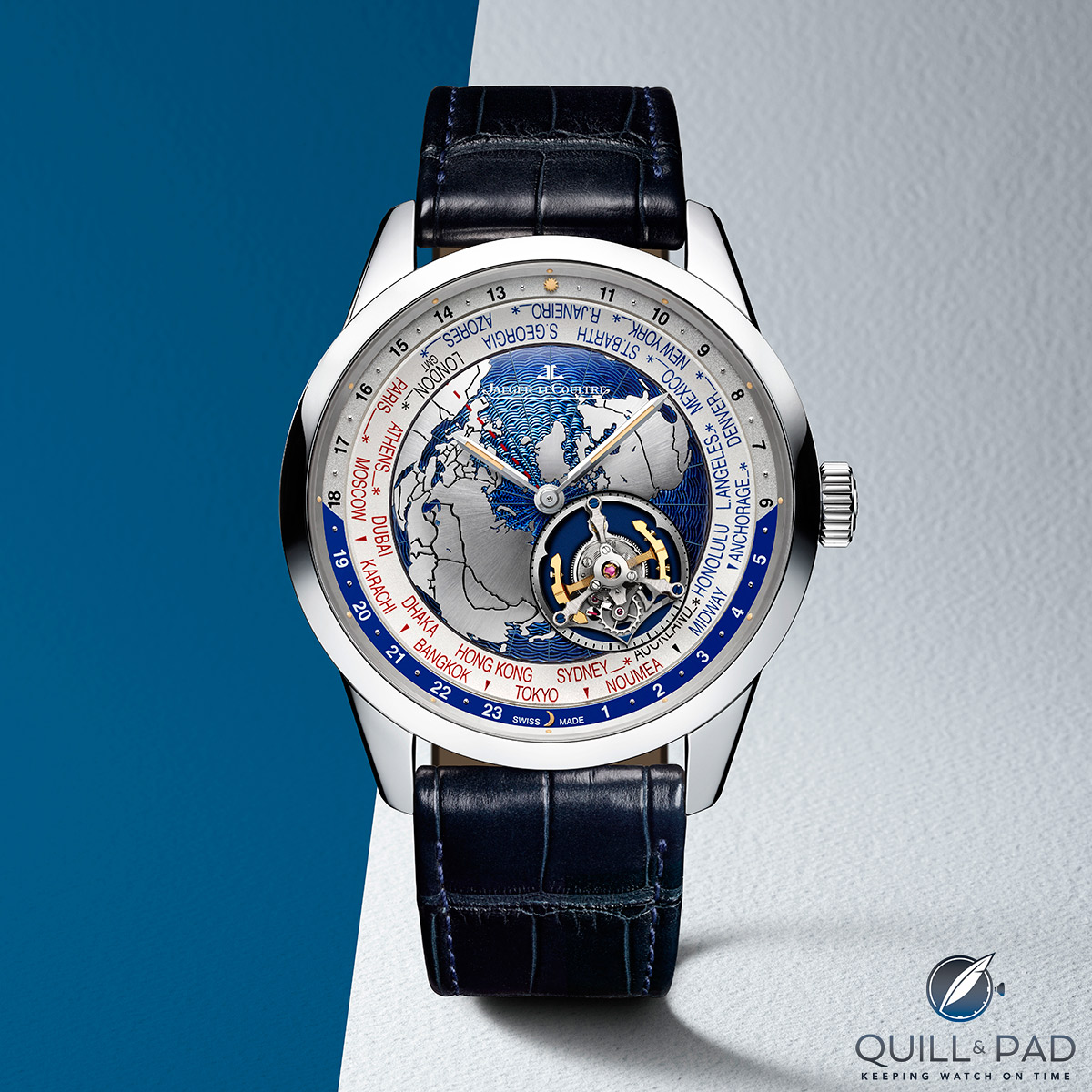
Jaeger-LeCoultre Geophysic Tourbillon Universal Time
Alas, it might have to (read: definitely will) stay on my wish list. One of the lucky owners of the 100 limited pieces might be getting a friendly phone call asking if I can pay a visit.
But until then, the breakdown!
- Wowza Factor * 8.25 The orbiting flying tourbillon projecting out from a partial globe is seriously a stunner.
- Late Night Lust Appeal * 94.2 » 923.786 m/s2 The lust of this watch is coupled with the desire to get out and travel, so it’s a double whammy!
- M.G.R. * 66.4 Any movement that includes an astronomically accurate function is already super cool, so having a flying tourbillon act as a satellite to the world is downright awesome!
- Added-Functionitis * Moderate World timers are technically only one additional function, but due to the large amount of information contained within the added mechanism, you definitely need extra-strength Gotta-HAVE-That cream for the worldly swelling!
- Ouch Outline * 10.2 Pulling an abdominal muscle! You often forget how crucial your core is for movement until one of your abdominal muscles is torn. Then, suddenly, getting around is drastically more taxing. Yet I would suffer through a thoroughly pulled muscle any day to get the Geophysic Tourbillon Universal Time on my wrist!
- Mermaid Moment * Give it a day! It will only take a day of watching that tourbillon orbiting the dial to know that you better put a ring on that finger! (Just go with it.)
- Awesome Total * 872 Subtract the number of pieces in the limited edition (100) from the caliber number (948) and then add the number of time zones visible at once (24) and the result is a gravitationally induced awesome total!
For more information, please visit www.jaeger-lecoultre.com/us/en/watches/geophysic/geophysic–tourbillon-universal-time.
Quick Facts Jaeger-LeCoultre Geophysic Tourbillon Universal Time
Case: 43.5 x 14.87 mm, platinum
Movement: automatic Jaeger-LeCoultre Caliber 948 with one-minute flying orbiting tourbillon
Functions: hours, minutes, seconds (on tourbillon); world time, day/night indicator
Limitation: 100 pieces
Price: $145,000

